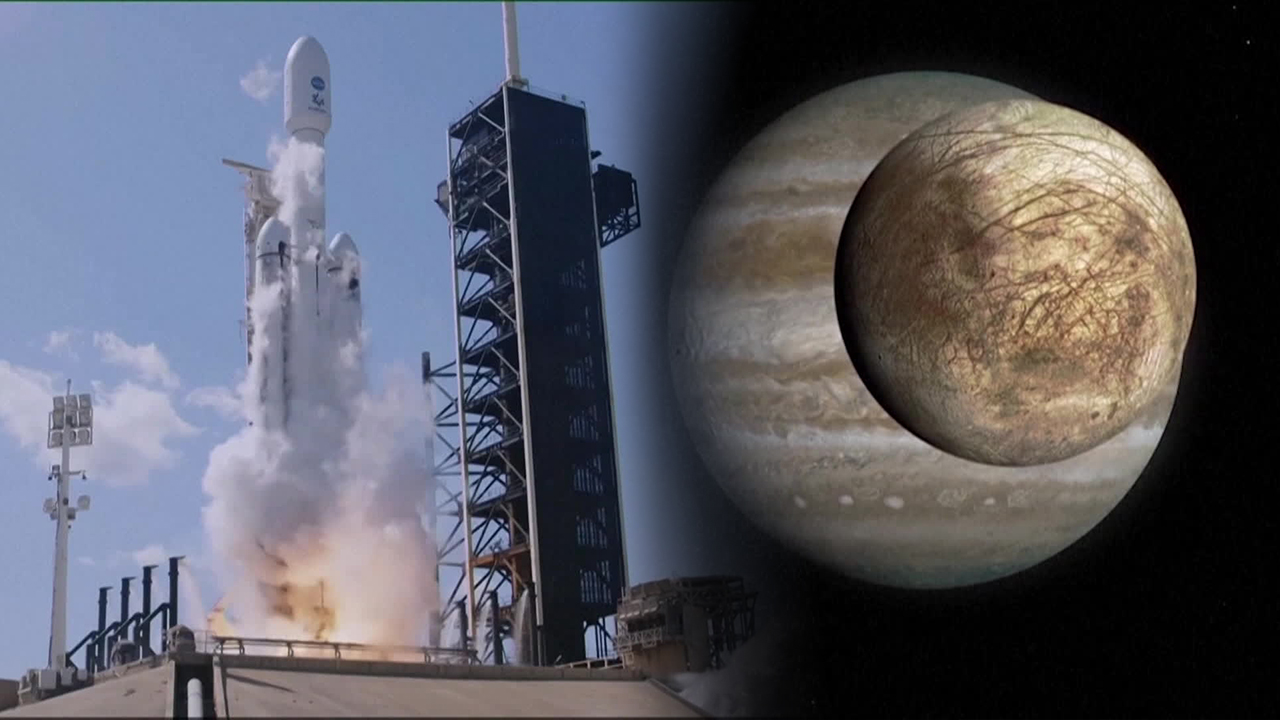Europa Clipper spacecraft launched to search for signs of life
입력 2024.10.16 (00:50)
읽어주기 기능은 크롬기반의
브라우저에서만 사용하실 수 있습니다.
[Anchor]
This is Europa, a moon orbiting Jupiter.
It is located about 770 million kilometers away from Earth.
That is five times farther than the distance between the Sun and Earth.
Its size is about 90% that of the Moon, making it the sixth largest moon in the solar system.
Scientists estimate that there is a vast ocean beneath Europa's thick ice layer.
If sunlight, water, and organic materials exist, scientists are hopeful about the possibility of finding life on Europa.
NASA's spacecraft 'Europa Clipper', which will help answer that question, has departed from Earth.
Kim Kyung-soo reports from Washington.
[Report]
["3, 2, 1, Ignition."]
SpaceX's Falcon Heavy rocket lifts off with the unmanned spacecraft 'Europa Clipper'.
One hour after launch, the spacecraft successfully escaped Earth's gravity and began its long journey to Jupiter.
It plans to travel a staggering 2.9 billion kilometers over the next five and a half years and enter the orbit of Europa in April 2030.
Finding clues of life on Europa is the most important goal of this mission.
[Gina DiBraccio/Acting Director of NASA's Planetary Science Division: "Given everything that we have really learned about the necessary conditions for life, Clipper is going to tell us if Europa has all of these ingredients for life."]
For this grand journey across the solar system, the Europa Clipper is equipped with over 2 tons of propulsion systems.
With various exploration equipment and large solar panels installed, a massive spacecraft over 30 meters long and weighing more than 5 tons has been created.
[Jordan Evans/Project Manager for NASA's Europa Clipper: "We had to build these giant solar panels to capture the small amount of sunlight at Jupiter to power the spacecraft and that's led us to having the largest planetary spacecraft for NASA ever."]
The spacecraft's body features the names of 2.6 million people who applied from around the world, along with a poem by American poet Ada Limón.
The U.S. government has invested $5.2 billion, approximately 7 trillion won, into this project to find clues of life.
This is Kim Kyung-soo from KBS News in Washington.
This is Europa, a moon orbiting Jupiter.
It is located about 770 million kilometers away from Earth.
That is five times farther than the distance between the Sun and Earth.
Its size is about 90% that of the Moon, making it the sixth largest moon in the solar system.
Scientists estimate that there is a vast ocean beneath Europa's thick ice layer.
If sunlight, water, and organic materials exist, scientists are hopeful about the possibility of finding life on Europa.
NASA's spacecraft 'Europa Clipper', which will help answer that question, has departed from Earth.
Kim Kyung-soo reports from Washington.
[Report]
["3, 2, 1, Ignition."]
SpaceX's Falcon Heavy rocket lifts off with the unmanned spacecraft 'Europa Clipper'.
One hour after launch, the spacecraft successfully escaped Earth's gravity and began its long journey to Jupiter.
It plans to travel a staggering 2.9 billion kilometers over the next five and a half years and enter the orbit of Europa in April 2030.
Finding clues of life on Europa is the most important goal of this mission.
[Gina DiBraccio/Acting Director of NASA's Planetary Science Division: "Given everything that we have really learned about the necessary conditions for life, Clipper is going to tell us if Europa has all of these ingredients for life."]
For this grand journey across the solar system, the Europa Clipper is equipped with over 2 tons of propulsion systems.
With various exploration equipment and large solar panels installed, a massive spacecraft over 30 meters long and weighing more than 5 tons has been created.
[Jordan Evans/Project Manager for NASA's Europa Clipper: "We had to build these giant solar panels to capture the small amount of sunlight at Jupiter to power the spacecraft and that's led us to having the largest planetary spacecraft for NASA ever."]
The spacecraft's body features the names of 2.6 million people who applied from around the world, along with a poem by American poet Ada Limón.
The U.S. government has invested $5.2 billion, approximately 7 trillion won, into this project to find clues of life.
This is Kim Kyung-soo from KBS News in Washington.
■ 제보하기
▷ 카카오톡 : 'KBS제보' 검색, 채널 추가
▷ 전화 : 02-781-1234, 4444
▷ 이메일 : kbs1234@kbs.co.kr
▷ 유튜브, 네이버, 카카오에서도 KBS뉴스를 구독해주세요!
- Europa Clipper spacecraft launched to search for signs of life
-
- 입력 2024-10-16 00:50:50

[Anchor]
This is Europa, a moon orbiting Jupiter.
It is located about 770 million kilometers away from Earth.
That is five times farther than the distance between the Sun and Earth.
Its size is about 90% that of the Moon, making it the sixth largest moon in the solar system.
Scientists estimate that there is a vast ocean beneath Europa's thick ice layer.
If sunlight, water, and organic materials exist, scientists are hopeful about the possibility of finding life on Europa.
NASA's spacecraft 'Europa Clipper', which will help answer that question, has departed from Earth.
Kim Kyung-soo reports from Washington.
[Report]
["3, 2, 1, Ignition."]
SpaceX's Falcon Heavy rocket lifts off with the unmanned spacecraft 'Europa Clipper'.
One hour after launch, the spacecraft successfully escaped Earth's gravity and began its long journey to Jupiter.
It plans to travel a staggering 2.9 billion kilometers over the next five and a half years and enter the orbit of Europa in April 2030.
Finding clues of life on Europa is the most important goal of this mission.
[Gina DiBraccio/Acting Director of NASA's Planetary Science Division: "Given everything that we have really learned about the necessary conditions for life, Clipper is going to tell us if Europa has all of these ingredients for life."]
For this grand journey across the solar system, the Europa Clipper is equipped with over 2 tons of propulsion systems.
With various exploration equipment and large solar panels installed, a massive spacecraft over 30 meters long and weighing more than 5 tons has been created.
[Jordan Evans/Project Manager for NASA's Europa Clipper: "We had to build these giant solar panels to capture the small amount of sunlight at Jupiter to power the spacecraft and that's led us to having the largest planetary spacecraft for NASA ever."]
The spacecraft's body features the names of 2.6 million people who applied from around the world, along with a poem by American poet Ada Limón.
The U.S. government has invested $5.2 billion, approximately 7 trillion won, into this project to find clues of life.
This is Kim Kyung-soo from KBS News in Washington.
This is Europa, a moon orbiting Jupiter.
It is located about 770 million kilometers away from Earth.
That is five times farther than the distance between the Sun and Earth.
Its size is about 90% that of the Moon, making it the sixth largest moon in the solar system.
Scientists estimate that there is a vast ocean beneath Europa's thick ice layer.
If sunlight, water, and organic materials exist, scientists are hopeful about the possibility of finding life on Europa.
NASA's spacecraft 'Europa Clipper', which will help answer that question, has departed from Earth.
Kim Kyung-soo reports from Washington.
[Report]
["3, 2, 1, Ignition."]
SpaceX's Falcon Heavy rocket lifts off with the unmanned spacecraft 'Europa Clipper'.
One hour after launch, the spacecraft successfully escaped Earth's gravity and began its long journey to Jupiter.
It plans to travel a staggering 2.9 billion kilometers over the next five and a half years and enter the orbit of Europa in April 2030.
Finding clues of life on Europa is the most important goal of this mission.
[Gina DiBraccio/Acting Director of NASA's Planetary Science Division: "Given everything that we have really learned about the necessary conditions for life, Clipper is going to tell us if Europa has all of these ingredients for life."]
For this grand journey across the solar system, the Europa Clipper is equipped with over 2 tons of propulsion systems.
With various exploration equipment and large solar panels installed, a massive spacecraft over 30 meters long and weighing more than 5 tons has been created.
[Jordan Evans/Project Manager for NASA's Europa Clipper: "We had to build these giant solar panels to capture the small amount of sunlight at Jupiter to power the spacecraft and that's led us to having the largest planetary spacecraft for NASA ever."]
The spacecraft's body features the names of 2.6 million people who applied from around the world, along with a poem by American poet Ada Limón.
The U.S. government has invested $5.2 billion, approximately 7 trillion won, into this project to find clues of life.
This is Kim Kyung-soo from KBS News in Washington.
-
-

김경수 기자 bada@kbs.co.kr
김경수 기자의 기사 모음
-
이 기사가 좋으셨다면
-
좋아요
0
-
응원해요
0
-
후속 원해요
0













![[단독] 한강버스 운항 두 달 남았는데…일부 공정률 ‘절반 이하’](/data/news/2025/07/01/20250701_LmwC7h.jpg)

이 기사에 대한 의견을 남겨주세요.